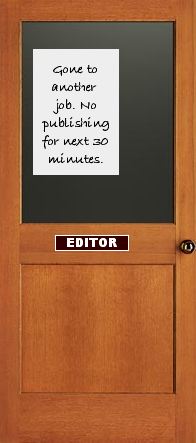1. Understanding Publishers
Who answers to whom in the publishing world is an incredibly complicated business. There are imprints that may or may not be almost independent from the publishing house to which they’re attached. (The independent ones are like independent music labels, still depending on a major label for all the things they can’t do themselves.) There are connections between Australian publishers and overseas publishers that may or may not tie in with the name and logo on the book. (Penguin Australia books look the same as Penguin UK books, yet they’re quite separate operations.) The variations and intricacies are mind-boggling.
The decision-making process within publishing houses isn’t quite so mind-boggling. The publisher, who used to be called the commissioning editor, makes the final decision, but the first person to read the MS is usually an in-house editor, or an out-of-house editor or reader. If a publisher likes the general look of your MS, it’ll be passed on to someone else for a full report.
There’s a great deal of outsourcing and freelancing in the publishing world. In the computer age, many of the jobs can be done from home and fitted in around family life. Most out-of-housers and freelancers have previously worked full-time in the industry and have developed links with one or more publishing house(s). Publisher’s readers may have developed links in other ways.
 One thing about full-time, in-house people is that they change positions and employers at an amazing rate. In Australia at least, it’s like musical chairs. Everyone hops around until the poor author can hardly keep up. One thing about full-time, in-house people is that they change positions and employers at an amazing rate. In Australia at least, it’s like musical chairs. Everyone hops around until the poor author can hardly keep up.
The poor author may become a very unhappy author if a particular nurturer at a particular publishing house moves off elsewhere. Naturally, the new person will want to make their own discoveries of talent, and may not feel so positive about someone else’s. The fairy tales had it right—the wicked stepmother syndrome!
Okay, let’s not get talking about disasters, though they do happen. Here’s another snag that happens far more often—at the interface between the editorial team and the sales and marketing team. Sales and marketing is a very large—huge—part of modern publishing, and nowadays they too have a say in what gets published.
I take back what I said before; the publisher’s decision is only final for the editorial team. There are still negotiations, persuasions and trade-offs to win endorsement from the sales and marketing team.
The rationale for involving sales and marketing is that they’re viewed as the experts on what will sell. They’re certainly the experts on what they can pitch to bookshop managers or owners or the head-offices of bookshop chains. A book has to click with the bookshop buyers before it ever gets the chance to click with the reading public.
So it’s complicated even here. The author has to sell to the publisher, the publisher has to sell to sales and marketing, the reps from sales and marketing have to sell to the bookshops, and finally the bookshops sell to the reading public. At every stage, the book has to be talked up in a slightly different way.
|





